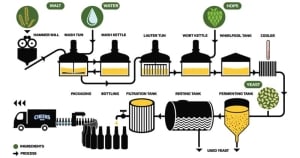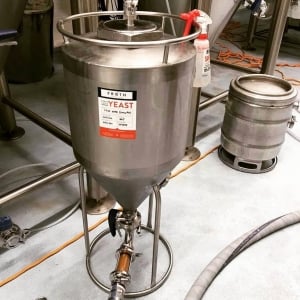Several stages and influencing factors of yeast growth
The 5 stages of yeast growth:
- Adjustment period: At this stage, the yeast has just accepted a new environment, and the temperature, pH, sugar content, water content, etc. have changed, which is the activation process of metabolism. The length of this stage fluctuates greatly, mainly depending on the type of organism, culture generation, culture conditions and other factors. The presence of oxygen during this period is critical, without which yeast cells will not be able to reproduce effectively. And this stage is easy to be invaded by bacteria, so this stage should be ended as soon as possible. The end of this phase is marked as soon as cells begin to detach.
- Acceleration phase: This phase is immediately followed by the adjustment phase. The yeast will quickly begin to decompose the fermentable sugars in the wort, and the speed of cell separation will be accelerated.
- Logarithmic growth phase: In this phase, yeast mainly performs aerobic respiration, cells proliferate logarithmically, and the proliferation rate is maximal and constant. At this point, the time required to form a new generation is the shortest (ie, the time to double the number of cells). The generation time was 90-120 min under the optimal proliferation conditions. Through the first two stages, the yeast has adapted to the new environment, and the oxygen, amino acids, sugars and trace elements in the wort are sufficient. The wort must be kept within a reasonable temperature range to maintain the benign reproduction of the yeast. Each yeast All strains can be fully grown and fermented and transferred to the stage of mass reproduction. The yeast at this stage has the most vigorous reproduction speed and the highest budding rate, which is the most suitable for the transfer stage of yeast expansion culture, and is also a suitable stage for inoculation.
4.Deceleration period: Due to various factors, such as a substantial decrease in the content of fermentable sugar and oxygen, and an increase in alcohol and carbon dioxide, the logarithmic growth phase has a certain time limit, and then enters a deceleration period in which the proliferation rate gradually decreases.
5.Stationary phase: During this phase, the number of microorganisms remains constant. The number of new cells formed is equal to the number of cells that died. Mass reproduction by logarithmic growth consumes a lot of nutrients and oxygen in beer, and alcohol, carbon dioxide and other metabolites inhibit the reproduction of yeast. And began to appear aging and death, and the number of deaths was basically the same as the number of yeasts that proliferated, reaching the peak of the total number of yeasts.
6.Dead phase: During this phase, more cells die than new cells are formed, and the number of cells decreases. After the previous continuous consumption, the remaining nutrients in the beer are less, and the reproduction of yeast cannot be fully nourished and inhibited by a large number of metabolites. At this stage, the number of dead yeasts was higher than the number of proliferating yeasts, and the total number of active yeasts continued to decrease. The yeast begins to agglomerate, slowly sinks into the can, and may become a source of contamination of beer and a factor affecting the taste of beer, which must be discharged in time.
Influencing factors:
Oxygen: suitable oxygen. The yeast needs sufficient oxygen during the breeding period, and the oxygen should be evenly distributed in the wort, and the wort should not be exposed to oxygen during the fermentation period.
Temperature: suitable temperature, according to different varieties of yeast, the suitable temperature is different. Generally speaking, the suitable temperature of the lower fermentation yeast is lower than the suitable temperature of the upper fermentation yeast. When heating or cooling, it should be carried out gradually and slowly, otherwise it will affect the growth of yeast.
Stress: Steady pressure, sudden changes in pressure that are too large can cause cell walls to rupture and increase yeast mortality.
Nutrients: Amino acid content should be sufficient
Sterile environment to avoid contamination of miscellaneous bacteria.
Trace elements: Insufficient zinc ion content, slow yeast growth, slow fermentation speed, high zinc ion content, fast yeast metabolism, easy aging and death.
The number of inoculated yeast: a small number of inoculations will increase the value of yeast for a long time, which increases the risk of contamination; if the number of inoculations is large, there will be less new yeast and more mature and senescent cells, which will affect the final recovery quality.
YoLong Brewtech has been engaged in consulting, design and manufacture of professional beer brewing equipment since 2004. And are actively sharing our expertise on more brewing and equipment. If you have any questions or requirements about brewing equipment, you can contact our professional technical engineers to find the answer. Contact Us!
Interested in learning more about Brewing Systems including additional details and pricing information? Please use the form below to contact us!






